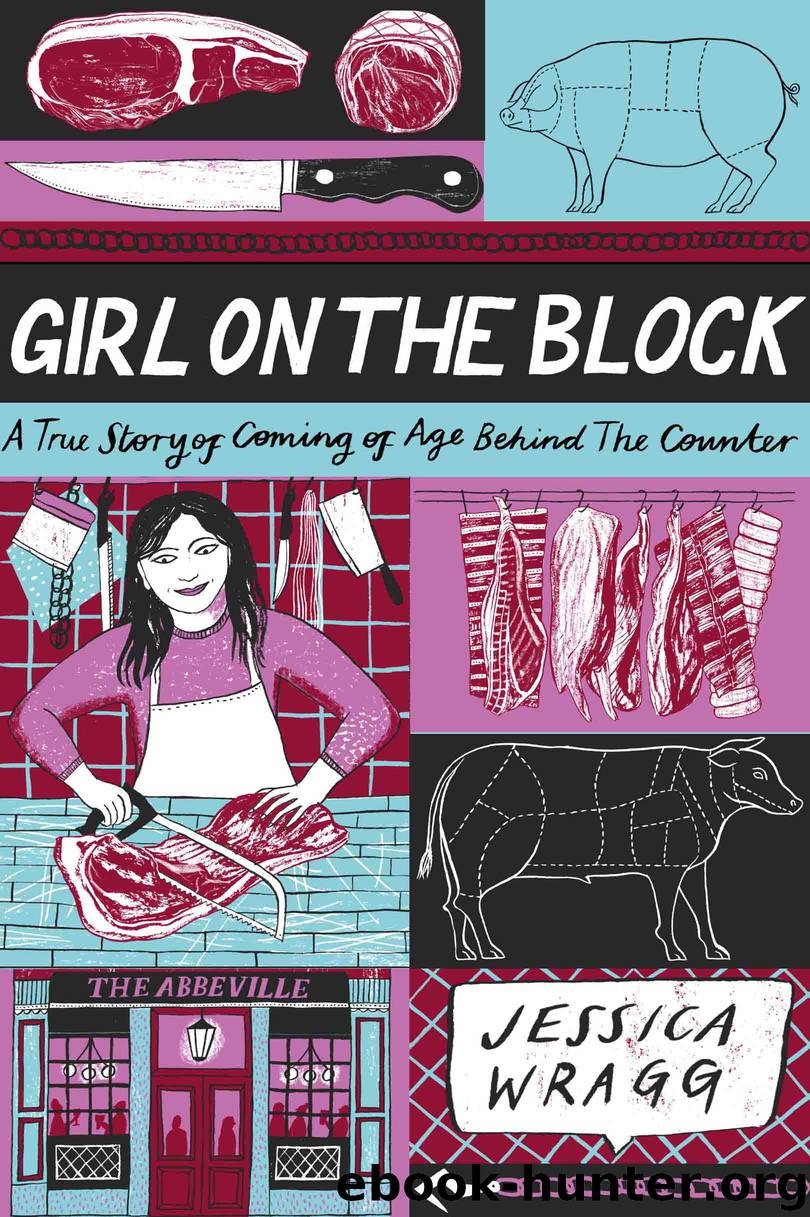Girl on the Block by Jessica Wragg

Author:Jessica Wragg
Language: eng
Format: epub
Publisher: HarperCollins
Published: 2019-06-12T16:00:00+00:00
Primal Cuts
Breaking Down a Lamb
Breaking down a lamb was one of the most useful things I was ever taught. Lamb meat is expensive, and the bones are small, so it is imperative to respect the animal and to take care when using your knife and your saws. The rack of lamb, the most expensive cut on the carcass, retails in the UK for an average of thirty pounds per kilo of free-range meat (roughly forty dollars).
Mastering the breakdown of a lamb is essential in another sense: once you understand the anatomy of a lamb, you can apply this understanding to other bovine beasts, large and small. A lamb is the first step in this chain of mastery, with bone and muscle structure that is almost identical to that of a pig, whose anatomy is similar to a cow, only smaller. The larger the animal, the more muscles there are to break apart, but the principle is the same.
To begin, source a carcass of lamb from your local butcher. Most good butcheries will deal with lamb in carcass form, so it shouldn’t be hard to find one. The fat should be creamy and white and the muscle beneath barely visible. If the muscles are visible through the top layer of skin, the meat will be lean and the animal is probably a bit older than lamb age (twelve months or less). You’ll also need a good-quality boning knife and a handsaw.
Place the lamb on a large, clean workspace with its cavity facing upward. The cavity is the area, hidden by the breasts, where the organs have been removed. The first step is to remove the breasts. At the front of the lamb are its forelegs, which will be bent slightly. Make the first cut just below them and run your knife from there down the cavity, tapering off toward the legs. Do the same on the other side—this will leave you with two breasts marked out in long oval shapes.
With your handsaw, begin at the top of the carcass and remove the breasts by using one hand to saw through the bone and the other to pull the meat slightly. You should only go through bone for half of the breast—the rest can be removed by using your boning knife to cut through the fat and skin. Do not put too much pressure on the saw. The trick is to let the saw do most of the work. The more you push, the harder it will be.
Once the breasts are removed, you should be able to see inside of the carcass and clearly make out the ribs running the length of it. Rib bones one to five are the shoulder and six to twelve are the rack of lamb. After the rack comes the saddle, then the chump and legs.
By removing the breasts you’ve allowed yourself clear space to cut between the bones. Count five ribs and make a long cut to the spine in between bones five and six on each side.
Download
This site does not store any files on its server. We only index and link to content provided by other sites. Please contact the content providers to delete copyright contents if any and email us, we'll remove relevant links or contents immediately.
| Culinary Biographies | Essays |
| Food Industry | History |
| Reference |
A Court of Wings and Ruin by Sarah J. Maas(7725)
The Death of the Heart by Elizabeth Bowen(3577)
The Sprouting Book by Ann Wigmore(3561)
Better Homes and Gardens New Cookbook by Better Homes & Gardens(3547)
BraveTart by Stella Parks(3414)
Salt, Fat, Acid, Heat: Mastering the Elements of Good Cooking by Nosrat Samin(3119)
Sauces by James Peterson(3071)
Kitchen confidential by Anthony Bourdain(3044)
The Bread Bible by Rose Levy Beranbaum(3035)
Classic by Mary Berry(2976)
Solo Food by Janneke Vreugdenhil(2943)
Ottolenghi - The Cookbook by Yotam Ottolenghi(2894)
Martha Stewart's Baking Handbook by Martha Stewart(2824)
Day by Elie Wiesel(2745)
Betty Crocker's Good and Easy Cook Book by Betty Crocker(2696)
The Plant Paradox by Dr. Steven R. Gundry M.D(2578)
My Pantry by Alice Waters(2576)
The Kitchen Counter Cooking School by Kathleen Flinn(2499)
Hot Sauce Nation by Denver Nicks(2466)
